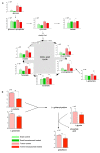Metabolomic and Lipidomic Profiling of Gliomas-A New Direction in Personalized Therapies
- PMID: 36291824
- PMCID: PMC9599495
- DOI: 10.3390/cancers14205041
Metabolomic and Lipidomic Profiling of Gliomas-A New Direction in Personalized Therapies
Abstract
In addition to being the most common primary brain tumor, gliomas are also among the most difficult to diagnose and treat. At present, the "gold standard" in glioma treatment entails the surgical resection of the largest possible portion of the tumor, followed by temozolomide therapy and radiation. However, this approach does not always yield the desired results. Additionally, the ability to cross the blood-brain barrier remains a major challenge for new potential drugs. Thus, researchers continue to search for targeted therapies that can be individualized based on the specific characteristics of each case. Metabolic and lipidomic research may represent two of the best ways to achieve this goal, as they enable detailed insights into the changes in the profile of small molecules in a biological system/specimen. This article reviews the new approaches to glioma therapy based on the analysis of alterations to biochemical pathways, and it provides an overview of the clinical results that may support personalized therapies in the future.
Keywords: gliomas; lipidomics; metabolomics; personalized medicine; pharmacotherapy.
Conflict of interest statement
The authors declare no conflict of interest.
Figures





Similar articles
-
Present and potential future adjuvant issues in high-grade astrocytic glioma treatment.Adv Tech Stand Neurosurg. 2009;34:3-35. doi: 10.1007/978-3-211-78741-0_1. Adv Tech Stand Neurosurg. 2009. PMID: 19368079 Review.
-
Metabolic Alterations Related to Glioma Grading Based on Metabolomics and Lipidomics Analyses.Metabolites. 2020 Nov 24;10(12):478. doi: 10.3390/metabo10120478. Metabolites. 2020. PMID: 33255474 Free PMC article.
-
Metabolomic signature of brain cancer.Mol Carcinog. 2017 Nov;56(11):2355-2371. doi: 10.1002/mc.22694. Epub 2017 Jul 17. Mol Carcinog. 2017. PMID: 28618012 Free PMC article. Review.
-
Molecular and genetic pathways in gliomas: the future of personalized therapeutics.CNS Oncol. 2014 Mar;3(2):123-36. doi: 10.2217/cns.14.7. CNS Oncol. 2014. PMID: 25055018 Free PMC article. Review.
-
Changing paradigms for targeted therapies against diffuse infiltrative gliomas: tackling a moving target.Expert Rev Neurother. 2019 Jul;19(7):663-677. doi: 10.1080/14737175.2019.1621169. Epub 2019 May 27. Expert Rev Neurother. 2019. PMID: 31106606 Free PMC article. Review.
Cited by
-
In Vivo and In Vitro Experimental Study Comparing the Effect of a Combination of Sodium Dichloroacetate and Valproic Acid with That of Temozolomide on Adult Glioblastoma.Int J Mol Sci. 2025 Jul 15;26(14):6784. doi: 10.3390/ijms26146784. Int J Mol Sci. 2025. PMID: 40725030 Free PMC article.
-
Glioblastoma mesenchymal subtype enhances antioxidant defence to reduce susceptibility to ferroptosis.Sci Rep. 2024 Sep 5;14(1):20770. doi: 10.1038/s41598-024-72024-8. Sci Rep. 2024. PMID: 39237744 Free PMC article.
-
Deciphering Glioblastoma: Fundamental and Novel Insights into the Biology and Therapeutic Strategies of Gliomas.Curr Issues Mol Biol. 2024 Mar 13;46(3):2402-2443. doi: 10.3390/cimb46030153. Curr Issues Mol Biol. 2024. PMID: 38534769 Free PMC article. Review.
-
Circulating Liquid Biopsy Biomarkers in Glioblastoma: Advances and Challenges.Int J Mol Sci. 2024 Jul 21;25(14):7974. doi: 10.3390/ijms25147974. Int J Mol Sci. 2024. PMID: 39063215 Free PMC article. Review.
-
The Role and Applied Value of Mitochondria in Glioma-Related Research.CNS Neurosci Ther. 2024 Dec;30(12):e70121. doi: 10.1111/cns.70121. CNS Neurosci Ther. 2024. PMID: 39639571 Free PMC article. Review.
References
-
- Louis D.N., Perry A., Wesseling P., Brat D.J., Cree I.A., Figarella-Branger D., Hawkins C., Ng H.K., Pfister S.M., Reifenberger G., et al. The 2021 WHO Classification of Tumors of the Central Nervous System: A Summary. Neuro-Oncology. 2021;23:1231–1251. doi: 10.1093/neuonc/noab106. - DOI - PMC - PubMed
Publication types
LinkOut - more resources
Full Text Sources

